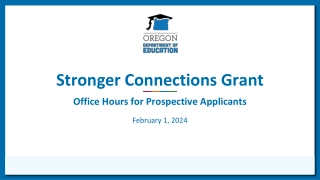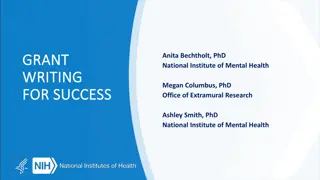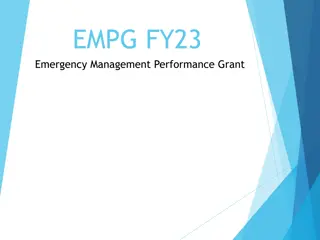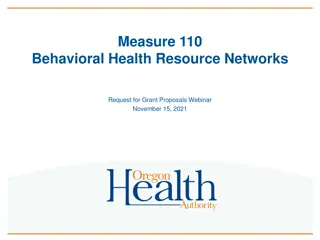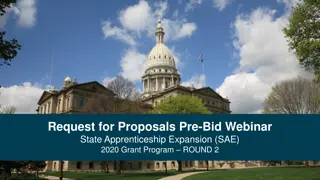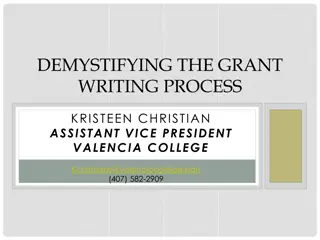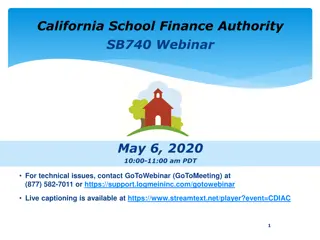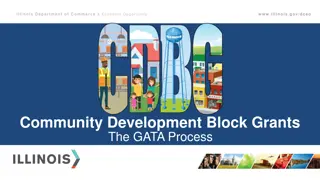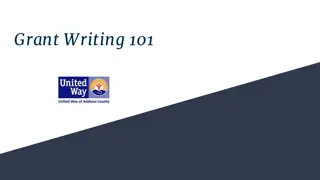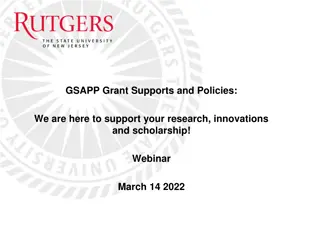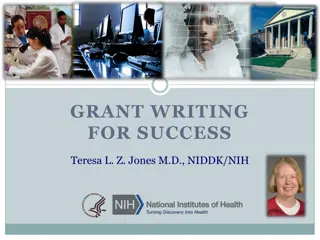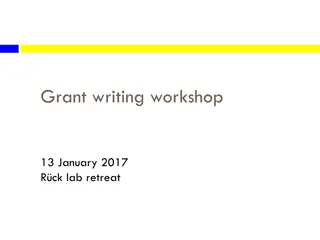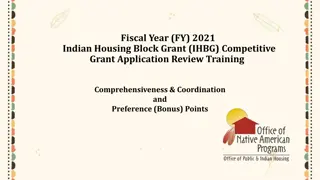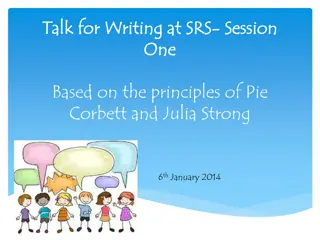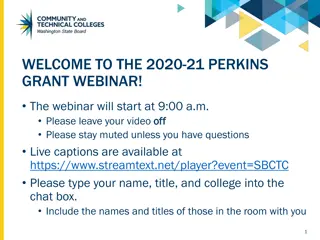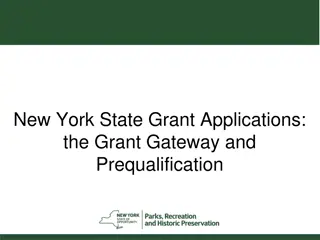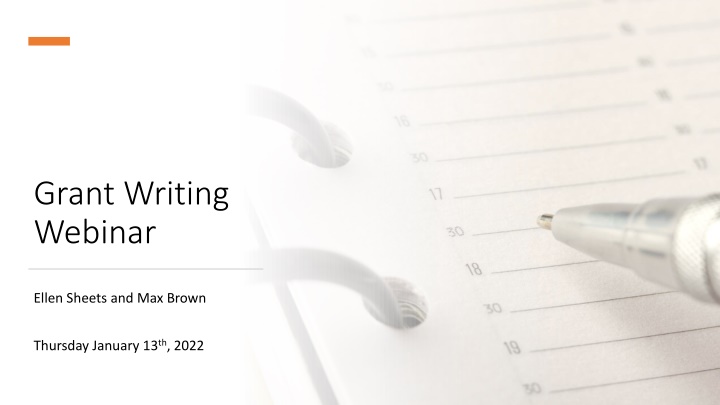
Grant Writing Webinar for Successful Applications
This webinar by Ellen Sheets and Max Brown on January 13th, 2022, provides essential training on grant application formalities, RFP understanding, common errors to avoid, and the importance of thorough application completion. The session aims to clarify confusing application sections and enhance participants' understanding of grant requirements. Find out why application training is crucial, how RFPs are created, and where to access proposals on the CJI website.
Download Presentation

Please find below an Image/Link to download the presentation.
The content on the website is provided AS IS for your information and personal use only. It may not be sold, licensed, or shared on other websites without obtaining consent from the author. If you encounter any issues during the download, it is possible that the publisher has removed the file from their server.
You are allowed to download the files provided on this website for personal or commercial use, subject to the condition that they are used lawfully. All files are the property of their respective owners.
The content on the website is provided AS IS for your information and personal use only. It may not be sold, licensed, or shared on other websites without obtaining consent from the author.
E N D
Presentation Transcript
Grant Writing Webinar Ellen Sheets and Max Brown Thursday January 13th, 2022
Application Webinar Formalities This training is being recorded and will be made available on the CJI website after the training is completed. There will be time for questions at the end of the webinar. Questions can be asked using the texting format within the webinar. Additionally, we will be allowing for emailed questions after the webinar and we will answer those questions via a Q&A document that will be available on the CJI website at a later date. We will not answer questions specific to an Agency s application, this webinar is to ensure that all that questions and sections are understood by those completing the application.
Application Webinar Formalities, cont Any questions specific to an agency s application should be forwarded to the agency s CJI Grant Manager. Max conducts an RFP webinar about 1 week after an RFP comes out during which he discusses any differences in the grant applications and answers general questions about the application.
Why is application training needed? To reinforce the essential review of the Request for Proposals (RFP) that are created for each application. To discuss the importance of applications being fully and accurately completed at the initial submission. To discuss the Review of applications To clarify sections of applications that are regularly completed incorrectly or not fully. To discuss common errors on applications
Requests for Proposals (RFP) What is a Request for Proposal? It is the document that CJI creates to explain the basic information about the grant such as the grant period, the application period and the funding source, what the grant funds can be used for- Program Scope, what is required to be submitted with the application, allowable and unallowable use of funds and much more information. Some information is consistent between all RFP s however there is important information specific to the grant funding source as well. It is essential that the RFP is read before each application is created and that it is utilized during the grant writing process as well.
RFP cont The Request for Proposals are located on the CJI website. The Website address is https://www.in.gov/cji/ There have been many changes to the website in the last year and it should be used as a resource.
Completing the Application Make sure to read the entire question and answer each part of the question. Several of the questions throughout the application have multiple parts. A question is not considered fully answered if not all parts are answered. For questions where data is requested, this should be current local and statewide statistical data. For questions where trends are being explained this should incorporate the most current data available. If any required documents are not attached with the application, then the application is not complete.
Grant Review and recommendations All CJI Grant awards are approved by the Indiana Criminal Justice Institute s Board of Trustees. The Board of Trustees (BOT) meets quarterly during which there is discussion and votes to approve (or deny) grant awards. The Board of Trustees have smaller committees that are assigned to each Division within CJI to meet and discuss application recommendations in depth and then provide information to the full Board of Trustees during the quarterly meetings for grant funding recommendations. Several of the funding sources recommendations are also discussed with Coalitions or Council s for their recommendations prior to the BOT subcommittee s meeting.
Grant Review and Recommendations cont When we score the application, these are some things we look at: If all questions are fully answered Goals/Objectives/Outcomes are SMART If the Goals/Objectives/Outcomes relate to the Problem identified in the application If the math is correct in the budget for both grant funds and match funds If the budget lines are described in detail in the budget narrative
Grant Review and Recommendations, cont Applications that are not complete- all questions not answered, incorrect math, Goals/Objectives/Outcomes not SMART or does not match Problem, Budget not fully explained in the budget narrative can be one reason applications are not funded at requested amount. Typically we do not reach out to agencies to ask questions about the application during the grant review process. This is why it is essential that applications are complete and budget narratives are very detailed to explain what the funds are being used for. When an agency asks for more grant funds than the previous grant cycle, we expect to see the information in the application change to reflect how the increased funds will improve the program from the prior grant period. Including updated Goals, Objectives and Outcomes.
Contact Information The contact information form populates the Document snapshot which is used by your Grant Manager when reaching out to your agency with information/questions so please ensure that the email address and phone numbers for everyone are accurate and up to date It should not be the same individual listed as all 3 contacts Fiscal Agent description on the application is different than the Fiscal Agent Role in IntelliGrants.
Fiscal Agent Contact vs Fiscal Agent Role Fiscal Agent Contact on the Contact section of the application is the person with your agency or in the County/City who is responsible for the Agency/County/City Financial Management. For Non-Profits this could be the Board Treasurer or a person hired within the agency to manage the fiscal side of the business. This person normally assists with fiscal reports and/or the budget section of applications. Their IntelliGrants Role should be either Administrator or Project Director. Fiscal Agent Role in IntelliGrants was created initially for the County Auditor/Treasurer or City Controller for a Governmental Entity to be able to sign electronically the grant agreement in IntelliGrants but would not be creating, approving or submitting fiscal reports. (Grant agreements are no longer signed in IntelliGrants)
Project Information Enter your Project Title and Project Summary Project title should not just be the name of the grant. Ex- Victims of Crime Act 2020-2022 Your project title should include the name of your program or tell us what services you will be providing Ex- Project SAFE: Survivors And Families Empowered In the Amount of Funding Requested box, this should only be the total Grant funds that are being requested in your application. Do not include match funds in this amount
Project Information Audit The audit is only required to be attached if you receive more than $750,000 in federal grant funds If you receive less than that, you are not required to attach an audit, but you are more than welcome to attach your most recent audit You will have to answer if there were any adverse findings in your audit, and if there were, explain what these findings were as well as attaching a Corrective Action Plan The Audit that is attached should not be the Programmatic Site Visit Packet/Letter that ICJI completes. This should be an actual audit completed by a CPA or State Board of Accounts. All government agencies (Prosecutor s Offices, Police Departments, Sheriff s Departments, Probation Offices) have audits that are completed bi-annually (or as set by State Board of Accounts) because they are apart of the city/county that is audited regularly by State Board of Accounts.
Programmatic Information In the Current Federal Award Amount should be the grant funded amount of your grant for the current period. If you are a new applicant to the grant, you will enter $0 Then you will have to answer questions about the services that will be provided by your program with the grant funds that you are requesting This page will look different for each grant application depending on the Funding type (VOCA, STOP, DVPT, FVPSA, etc.) At the bottom of this page you will have to mark whether your program is a Continuation or a New program. If it is a Continuation program, you will have to answer some questions about the success of your previous grant with the goals and objectives. You will also have a question to explain any challenges/barriers that prevented the successful completion of your goals and objectives from the previous grant period.
Programmatic Information STOP Grant Only STOP Grant Only For STOP applicants, the Programmatic Information will have some extra questions about the Percentages of your program that are associated with each category of STOP Prosecutors, Law Enforcement, Victims Services, Courts These percentages are for the percentage of funds that you are requesting for each category of services, not for what your agency services are Ex- If you are a prosecutor s office funding a Victim Advocate, that would go 100% to Victims Services instead of Prosecutor If the funds are being split between multiple categories, the percentages should be split by the percentage of money associated with each category Ex- $100,000 total requested in grant funds, 1 Victim Advocate for $40,000 and a Deputy Prosecutor for $60,000 What should the percentages be and for which categories? No one should have any Courts percentages in their application except a Court applicant
Problem Statement & Analysis Problem Statement Should be short and address the problem that your program is addressing should be victim focused not required but should not be inward focused Severity of the Problem This should be statistics about the problem in your community compared to the statewide/national problem Show us that there is a problem and how serious the problem is Alleviate the Problem How will your program address the problem what services will be provided, who will you serve, what will the effect be of these services?
Goals, Objectives, & Outcomes Goal Your goal should directly address the problem in the problem statement Should be victim focused and be the goal for the program that is being funded You can have more than one goal for your grant Objectives All objectives should be S.M.A.R.T Specific, Measurable, Achievable, Realistic, Timely Should be a benchmark within your program that you are wanting to achieve Outcomes Outcome will be the result of the objective by the end of the grant period Should be at least 1 outcome for each objective
Goals, Objectives & Outcomes This section should not be the same in each application. In each grant cycle, Agency s should be looking to improve their services or modify services to meet their clients needs and should be reflected in this section. This is especially true if the application is for more grant funds than the previous application but is also true for programs that are not requesting more grant funds. Programs should always strive to grow and improve services. The Goals, Objectives and Outcomes should be different for different funding sources. Each funding source is likely to be funding different aspects of the Agency s program and Goals, Objectives and Outcomes should reflect these differences.
Program Description This is the Who, What, When, Where, How, and Why of your program What Describe the nature of the proposed Program Who is your target population, parties responsible for implementing program, and any partners involved Where will the program provide services? Counties, office locations and geographical area being served Why Explain the rationale for the selection of the proposed program When is the Timeline for the program How- Provide any resources and activities used for the implementation of your program Be sure to read the entire question and answer the entire question.
Evidence Based Practices / Use of Volunteers Evidence Based Practices Each program should have an Evidence Based Program (EBP) or Best Practice (BP) that should be named along with any sources for it. Evidence Based Programs/Best Practices are research based and sources should reflect the research that verifies it as EBP or BP Use of Volunteers Volunteers are a requirement of VOCA so all VOCA applications should have Yes selected unless submitting a Volunteer Waiver
Budget Forms - General For all budget forms, you should not list only the amount you are wanting reimbursed for. You should list the full Salary, annual expense, etc and adjust the percentages to calculate to the end cost that you are requesting This happens the most in Personnel and Operating Expenses- you should list the full annual amount of the operating expenses and adjust the percentage as needed. Be realistic and accurate with the grant budget so that there is less than 5% deobligation, or unused funds, at the end of the grant period.
Budget Forms - Personnel Once again please make sure you list the full salary/hourly rate for all listed employees You will click the check box for each Personnel Type that you will be requesting Salaried, Hourly, Law Enforcement Pool, Pool, Volunteer If you click the box for one of these sections and enter information into this section, you must remove it before unchecking the box if you no longer want the positions in this section The information is still included by Intelligrants in the Budget Summary if it is not removed
Personnel Budget Dos and Donts Don t Do
Budget Forms- Benefits Benefit Percentage for grant funded line items cannot be more than the percentage for the position s Salary percentage. It can, however, be less. The Benefit Percentage, the Calculated Annual Cost of Benefit and the Cost columns must be completed by the applicant as the Cost column is not automatically figured by IntelliGrants. The Calculated Annual Cost of Benefit is the total amount of the benefit for the line item time period. Each benefit type must be broken out in the budget. Health, Life, Dental and Vision can not be in one line item together. They must be separated.
Benefits Page Common Mistakes
Budget Forms Supplies & Operating Expenses Supplies are tangible items such as paper, pens, toner, Operating Expenses are the expenses the agency pays for overhead such as Rent, utilities, services such as printing, trash, pest control, snow removal, telephone, internet. Operating expenses must be prorated to reflect the percentage the grant is to the agency s annual budget or the percentage that the program utilizes the expense (such as printing) Any line item that is a general category such as Office supplies, Cleaning supplies, Utilities, must have the specific office supplies or cleaning supplies listed in the budget narrative.
Equipment Equipment costs more than $500, if it costs $500 or less then it should be listed in supplies. Equipment is tangible- Software or Cloud storage should be listed under Operating expenses regardless of the cost. Equipment must be inventoried within your agency so that the piece of equipment can be tracked for when we or auditors need verification that the equipment is still being used and in good repair. Equipment purchases require following Procurement rules along with a detailed explanation of how the equipment purchase decision was made along with 3 other bids or pricings for the same/similar equipment.
Travel The Travel section is for travel for agency staff and includes local travel, statewide travel and travel to other States for verified conferences. There are some circumstances that volunteers travel can be paid for as well, please discuss these with your CJI Grant Manager if you have questions. The RFP has a link to the IDOA travel policy. This policy is what we utilize when looking at Per Diem amounts, within State hotel rates, and mileage.
Consultants & Contractors A Consultant evaluates an organization s needs and provides professional advice. A Contractor provides goods or performs services. Additionally, a Consultant s expense is limited to a rate of $81.25 per hour or $650 a day A contractor is not subject to the above maximum rate For both Consultants and Contractors, the costs must be reasonable based on the nature and scope of the service and the cost of similar services in the area.
Consultants & Contractors Either at the time the application is submitted OR when the first fiscal report with Consultant/Contractor reimbursement requested the Executed Contract or Memorandum of Understanding must be attached and it must at a minumum include the following: Time Period effected (must be current) Duties of each party Pricing of Goods/services (hourly rate, cost per item, etc as applicable) Signature of each party
Program Income Program Income is defined as gross income earned by the non-Federal entity that is directly generated by a supported activity or earned as a result of the Federal award during the period of performance. Examples: Registration Fees Membership dues More information regarding Program Income can be found in the Documentation Policy that was sent out from CJI in early January 2022. Any questions should be referred to your Grant Manager
Budget Summary The Budget Summary page automatically pulls information from the Budget sections. The top grid section on the Budget Summary page is the Total Budget by Category and this grid includes match when match is a required part of the grant. The second grid section is the Total Budget by fund source which breaks down the total amount of grant and match funds, if match is relevant. This section is important because it shows the % of grant funds and the % of match funds.
Budget Narrative The Budget Narrative section is another section of the application that is rarely completed fully. This section should be used to explain in detail how each line item will be used within the program. Additionally, there must be an explanation of exactly what will be included into any general categories, including but not limited to Utilities, office supplies, program supplies, or client needs. If the item is not listed in the budget narrative for one of the general categories, then the item will not be reimbursable.
Budget Narrative Each narrative box within the Budget Narrative has multiple questions within each section, each of these questions must be answered. Internal Controls is an essential section that must be completed fully. An explanation of each agency s polices, procedures and systems in place to ensure your agency is following all rules, regulations and laws governing the grant should be included. This should be a detailed explanation of the organization s account for grant funds, tracking programmatic achievements, maintaining adequate records and exercising control over the grant.
Required Attachments There are several required attachments that are consistent for each funding source and then there are a couple attachments required for specific grants One of the required attachments for Non-Profit Agencies (Governmental Agencies are exempt from this attachment) is the Subgrantee Basic Budget/Total Agency Budget which consists of two tabs- Organization tab and Employee tab. This form is available through a link on the RFP and this form is required, it cannot be your own document.
Required Attachments cont The Subgrantee Basic budget/Total Agency Budget is frequently completed incorrectly as well. The Revenue/Expenditure page should be completed fully with providing specific details as to the revenue sources for the program. This should include listing specific funding sources such as other Federal or State Grants, Foundation funds and program income if applicable. Lines should be added if needed when listing each funding source Instructions are on the document that explains what needs to be listed out individually and that additional lines can be added as necessary. There is an additional line for Other Contributions if there is an income source that does not fit in any of the other columns.
Expenditure Details Current Budget Previous Years Expenditures Salaries/Wages Benefits Payroll Taxes Professional Contract Services Advertising, Promotion Office/Operational Expenses Information Technology Phone Rent/Facility Travel Conferences/Meetings Insurance Training Grants/Assistance to Individuals Client Transportation Program Materials/Resources Residential Housing Supplies Residential Food/Meals Printing/Copying Costs Postage Utilities Equipment Other (Please identify) Total: $0.00 $0.00
Required Attachments cont Subgrantee Basic Budget/Total Agency Budget: The employee tab should be completed for those positions that are grant funded. It is not necessary to put the positions on the grant that are only match. The information entered in the employee tab should be consistent with the budget for the grant. For example, the salary or hourly pay should be the same on the Subgrantee Basic Budget as it is in the Personnel Section of this grant s budget. The % s that the employees are on other grants should be accurate as well, we will be checking those other grants to ensure the % s are correct. The total percentage of salary for the employees should be 100% and the other category must be explained in the source of other funds. This section should never have unknown as the other category.
Fill out this form only for employee's who will be paid with funds from this grant. Employee Name Job Title Salary/Rate Amount for Benefits FT/PT Hours per Week Funding Streams - % of Time Total Source of Other Funds Foundation funds Foundation funds/ Donations DVPT FVPSA SASP SSBG STOP SAVAF VOCA Other Victim Advocate Victim Advocate Supervisor $ Susie Smith $19.50/hr FT 40 30.0% 20.0% 40.0% 10.0% 100% 25,000.00 $ Jenny Jones $45,000/yr FT 40 25.0% 10.0% 20.0% 45.0% 100% 30,000.00 0% 0%
Required Attachments, cont Indirect Cost Rate Is Federally approved and Agency will have an approval Letter with effective date and approved rate Current approval letter must be attached to this section Indirect cost rate will only be allowable on the grant while it is approved, if it ends during the grant period then it must be renewed before the end of the previous agreement, or it will have to be ended on the grant. De Minimis Is 10% of modified total direct costs (MTDC), then a list must be provided of indirect costs and the calculation used to determine the amount charged
Required Attachments, cont Sustainability Plan details the applicant s plan to maintain the program once the grant fund period expires. Agencies should have a plan for how to continue services if funds are decreased or ended Timeline for the completion of the funded project and/or expenditure of grant funds for this project.
Required Attachments cont Letters of Endorsement: These letters should be from Community Agencies that evidences their support for the grant funded program specific to this application. STOP GRANT REQUIRED ONLY FOR GOVERNMENTAL ENTITIES Consultation letter- This letter shows that Court, Law Enforcement and Prosecutors have consulted with a Non-Profit Agency during the completion of the STOP application. Example of form is attached in the back of the STOP RFP.
Required Attachments, cont LEGAL SERVICES CERTIFICATION LETTER- STOP GRANT ONLY If the Agency is planning on utilizing STOP Funding to support legal assistance then they must submit a letter stating that they will comply with all statutory requirements. Example at the end of the RFP. Miscellaneous: Completed and signed EEOP Certification form If this is a Governmental entity then this form should be for the entire County or City, not just the specific agency. Job Descriptions for all positions listed on the budget, including those that are only match lines If applicable, attach other requested information
Important reminders Read the RFP before starting application Answer questions fully, including each part of the question Ensure that math is accurate in the budget and line items are in the correct categories Be very specific and detailed in the budget narrative answering all questions and explaining all line items Make sure the Goals, Objectives and Outcomes are SMART- Specific, Measurable, Achievable, Realistic and Timely and you must create a system to measuring the specific objectives and outcomes so that they can be reported in the Program Reports.
Contacts For Questions MaxBrown@CJI.in.gov Esheets1@CJI.in.gov Please send any questions about the Application training to both Max and Ellen We will be creating an Applications Q&A page with questions from the training and from emails to put on the CJI website in the near future.

